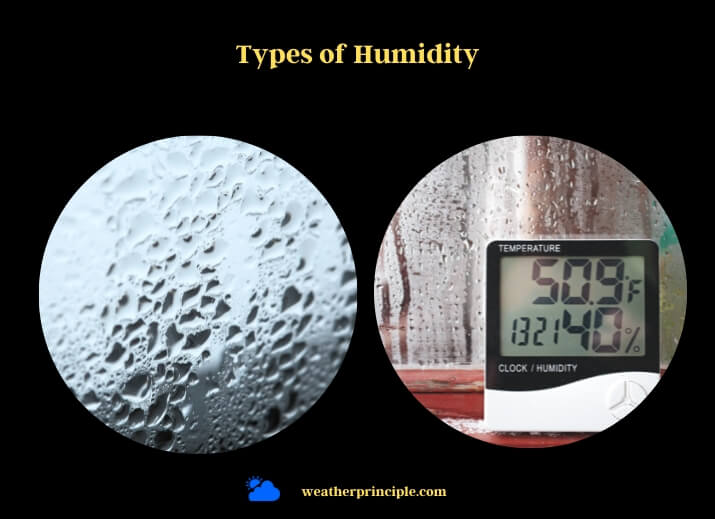Published on: May 13, 2023
Written by Taha Nur / Fact-checked by Kader Khan
Humidity is a crucial factor in our daily lives, affecting everything from our comfort and health to agriculture and industry. Understanding the mysteries of humidity can help us adapt to various environments and optimize our living and working conditions.
Humidity is the measure of water vapor in the air. It is an essential aspect of Earth’s weather and climate, and it impacts various phenomena, including precipitation, fog, and cloud formation.
Types of Humidity
Absolute Humidity
Absolute humidity is the total amount of water vapor present in a given volume of air. It is typically measured in grams per cubic meter (g/m³) and can vary based on temperature and pressure.
Relative Humidity
Relative humidity is the ratio of the actual amount of water vapor in the air to the maximum amount the air can hold at a specific temperature. It is expressed as a percentage and is the most commonly used measure of humidity.

Specific Humidity
Specific humidity is the ratio of the mass of water vapor to the total mass of air, including the water vapor. It is measured in grams per kilogram (g/kg) and is primarily used in meteorology and climatology.
Comparing the Different Types
Each type of humidity provides unique insights into atmospheric conditions. Absolute humidity offers a direct measure of moisture content, while relative humidity is more relevant to human comfort and weather phenomena. Specific humidity is useful for understanding the larger-scale processes that drive climate and weather patterns.
Measuring Humidity
Hygrometers
Hygrometers are instruments used to measure humidity. There are several types of hygrometers, including:
Hair Tension Hygrometers
These devices use a human or animal hair’s response to changes in humidity. The hair will lengthen or shorten with changes in humidity, and this movement is converted into a humidity reading.
Sling Psychrometers
Sling psychrometers consist of two thermometers, one dry and one wet, attached to a rotating handle. By comparing the temperature difference between the two thermometers after spinning, the relative humidity can be calculated.

Electronic Hygrometers
Electronic hygrometers use sensors that change their electrical resistance or capacitance with fluctuations in humidity. These changes are then converted into humidity readings.
Dew Point
The dew point is the temperature at which air becomes saturated and water vapor begins to condense into liquid droplets. It is a valuable measure of humidity and can help predict the formation of dew, frost, and fog.
Humidity Charts and Calculations
Humidity charts, such as the psychrometric chart, are used by engineers and meteorologists to visualize the relationships between humidity, temperature, and other atmospheric properties. These charts can help in understanding and predicting weather phenomena and controlling indoor environments.
Humidity and Climate
Factors Affecting Humidity
Several factors can influence humidity, including:
Temperature
Warm air can hold more water vapor than cold air, so higher temperatures generally lead to higher humidity levels.
Wind
Wind can transport moist air from one region to another, affecting local humidity levels.
Vegetation
Areas with more vegetation tend to have higher humidity levels due to the process of transpiration, where plants release water vapor into the atmosphere.
Geographic Variations in Humidity
Humidity levels can vary significantly based on geographic location:
Coastal vs. Inland
Coastal areas generally have higher
Coastal vs. Inland
Coastal areas generally have higher humidity levels due to their proximity to large bodies of water, which provide a constant source of moisture. Inland areas, especially in arid and semi-arid regions, typically have lower humidity levels.

Altitude
Humidity levels tend to decrease with altitude as the air becomes thinner and holds less moisture.
Seasonal Variations in Humidity
Humidity levels can fluctuate throughout the year, with some regions experiencing higher humidity levels during specific seasons. For instance, many tropical areas have distinct wet and dry seasons, while temperate regions may experience higher humidity levels during the warmer months.
Humidity and Weather Phenomena
Cloud Formation
Humidity plays a critical role in cloud formation. As warm, moist air rises, it cools and expands. When the temperature drops below the dew point, the water vapor in the air condenses around microscopic particles called cloud condensation nuclei, forming clouds.
Fog and Mist
Fog and mist are formed when the air temperature cools to the dew point, and water vapor condenses into tiny droplets suspended in the air. High humidity levels, combined with specific temperature and wind conditions, can lead to the formation of fog and mist.
Rain and Precipitation
Humidity is a crucial factor in the development of rain and other forms of precipitation. When enough water vapor condenses in the atmosphere, it can form droplets that combine and grow, eventually falling as precipitation.
Snow and Ice
Cold temperatures and high humidity levels can lead to the formation of snow and ice. As moist air cools, water vapor can directly freeze into ice crystals, which then aggregate to form snowflakes.
Humidity and Human Comfort
Heat Index
The heat index is a measure that combines temperature and humidity to determine how hot it feels to the human body. High humidity levels can make the air feel much hotter than the actual temperature, leading to discomfort and potential health risks.
Discomfort at High Humidity
High humidity levels can cause discomfort as the body’s natural cooling mechanism, sweating, becomes less effective. When the air is saturated with moisture, sweat evaporates more slowly, making it harder for the body to cool down.
Discomfort at Low Humidity
Low humidity levels can also cause discomfort as the dry air can lead to skin irritation, dry eyes, and respiratory issues.
Ideal Humidity Levels for Comfort
The ideal indoor humidity level for human comfort is generally between 30% and 60%. Maintaining humidity levels within this range can help promote comfort and reduce the risk of health issues associated with extreme humidity levels.
Humidity in Buildings
Importance of Indoor Humidity Control
Controlling indoor humidity levels is essential for maintaining a comfortable living environment and protecting the structural integrity of buildings.
Effects of Humidity on Building Materials
Excess humidity can cause damage to building materials, such as wood, drywall, and insulation, by promoting the growth of mold and mildew and causing materials to warp, swell, or rot.
Humidity Control Techniques
There are several methods for controlling indoor humidity levels:
Ventilation
Proper ventilation can help regulate humidity levels by allowing fresh air to circulate and expel excess moisture.
Dehumidifiers
Dehumidifiers work by removing excess moisture from the air and can be an effective way to maintain comfortable humidity levels in damp environments.
Humidifiers
Humidifiers add moisture to the air, which can be beneficial in dry environments where low humidity levels cause discomfort or damage to building materials.
Mold and Mildew Prevention
Controlling humidity levels is essential for preventing the growth of mold and mildew in buildings. Proper ventilation, regular cleaning, and moisture control measures can help keep these unwanted organisms at bay.
Humidity and Health
Respiratory Issues Related to Humidity
Humidity levels can significantly impact respiratory health. High humidity levels can exacerbate asthma and allergies by promoting the growth of mold, mildew, and dust mites. Low humidity levels can cause dryness and irritation in the respiratory system, making it more susceptible to infections.
Skin Problems Related to Humidity
Humidity can also affect the skin. High humidity levels can cause excessive sweating and exacerbate skin conditions like acne and eczema. Low humidity levels can lead to dry, itchy, and irritated skin.
Infection Risks and Humidity
Humidity levels can influence the survival and spread of bacteria and viruses. Some pathogens thrive in high humidity environments, while others prefer low humidity conditions. Maintaining appropriate humidity levels can help reduce the risk of infection.
Humidity in Agriculture
The Role of Humidity in Plant Growth
Humidity plays a vital role in plant growth and development. High humidity levels can promote the growth of mold and fungal diseases, while low humidity levels can cause plants to lose water through transpiration, leading to dehydration and stress.

Managing Humidity for Optimal Crop Yields
Farmers must carefully manage humidity levels to ensure optimal crop yields. This may involve using irrigation systems, greenhouses, or other humidity control measures to create the ideal growing conditions for various crops.
Greenhouse Humidity Management
Greenhouses offer a controlled environment for growing plants, including the ability to regulate humidity levels. Proper humidity management in greenhouses is crucial for preventing plant diseases, promoting healthy growth, and maximizing crop yields.
Humidity in Industry
Humidity in Manufacturing Processes
Humidity control is essential in various manufacturing processes, as it can impact product quality and consistency. For example, humidity levels can affect the drying of paints and coatings, the curing of adhesives, and the formation of condensation on cold surfaces.
Humidity Control for Electronics
Controlling humidity levels is crucial in the electronics industry, as excess moisture can cause corrosion, short-circuiting, and other damage to sensitive components. Many electronic devices include built-in humidity sensors and control systems to prevent damage caused by excess moisture.
Humidity and Corrosion
Humidity can accelerate the corrosion of metals, leading to premature failure of structures, machinery, and equipment. Proper humidity control can help mitigate corrosion and extend the lifespan of valuable assets.
Conclusion
The Importance of Understanding Humidity
Understanding the mysteries of humidity is crucial for navigating various aspects of our lives, from maintaining comfortable living spaces to optimizing agricultural and industrial processes. By gaining a better understanding of humidity, we can adapt to different environments and create healthier, more productive spaces.
Adapting to Different Humidity Levels
Adapting to different humidity levels requires awareness and appropriate measures to maintain comfort, health, and the integrity of our surroundings. By learning about the effects of humidity and implementing effective humidity control strategies, we can thrive in any environment.
FAQs
What is the ideal indoor humidity level?
The ideal indoor humidity level for human comfort and health is generally between 30% and 60%.
How does humidity affect our perception of temperature?
Humidity affects our perception of temperature because it influences the effectiveness of our body’s natural cooling mechanism, sweating. High humidity levels can make the air feel hotter than the actual temperature because sweat evaporates more slowly, making it harder for our bodies to cool down.
Can humidity levels affect the spread of viruses and bacteria?
Yes, humidity levels can impact the survival and spread of viruses and bacteria. Some pathogens thrive in high humidity environments, while others prefer low humidity conditions. Maintaining appropriate humidity levels can help reduce the risk of infection.
What are the primary factors influencing humidity?
The primary factors influencing humidity include temperature, wind, and vegetation. Warm air can hold more moisture than cold air, so higher temperatures generally lead to higher humidity levels. Wind can transport moist air from one region to another, affecting local humidity levels. Areas with more vegetation tend to have higher humidity levels due to the process of transpiration, where plants release water vapor into the atmosphere.
How can I control the humidity levels in my home or workplace?
You can control humidity levels by using proper ventilation, dehumidifiers, and humidifiers. Ventilation allows fresh air to circulate and expel excess moisture, while dehumidifiers remove excess moisture from the air, and humidifiers add moisture to the air in dry environments. Maintaining an indoor humidity level between 30% and 60% can help promote comfort and reduce the risk of health issues associated with extreme humidity levels.
You might also like:



